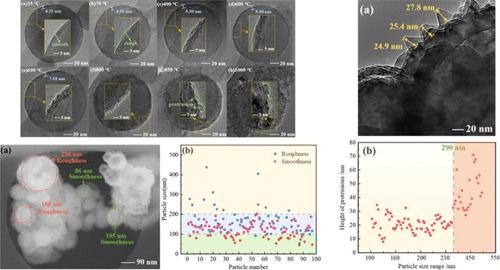当前位置:
X-MOL 学术
›
J. Phys. Chem. C
›
论文详情
Our official English website, www.x-mol.net, welcomes your feedback! (Note: you will need to create a separate account there.)
Experimental Study on the Alumina Shell Protrusions of Aluminum Nanoparticles during the Aerobic Heating Environment
The Journal of Physical Chemistry C ( IF 3.7 ) Pub Date : 2024-03-20 , DOI: 10.1021/acs.jpcc.4c00190 Zhengqing Zhou 1, 2 , Qi Liu 1, 2 , Lujia Chai 1, 2 , Huiling Jiang 1, 2 , Liang Zhou 1, 2 , Tianyi Wang 3
The Journal of Physical Chemistry C ( IF 3.7 ) Pub Date : 2024-03-20 , DOI: 10.1021/acs.jpcc.4c00190 Zhengqing Zhou 1, 2 , Qi Liu 1, 2 , Lujia Chai 1, 2 , Huiling Jiang 1, 2 , Liang Zhou 1, 2 , Tianyi Wang 3
Affiliation

|
The alumina shell plays a crucial role in the energy release of aluminum powder. The experimental results indicate the presence of protrusions on the alumina shells during the process of aerobic heating. To investigate the causes of protrusion formation during the aerobic heating process, in situ transmission electron microscopy was employed to observe the process of protrusion formation. The experiment revealed that within the temperature range of 70–850 °C, the alumina shell undergoes a gradual transition from smooth to rough, accompanied by the emergence of protrusions at 850 °C. This is because, for 35–500 nm aluminum particles (ANPs), larger particle sizes generate greater internal and tensile stresses, thereby increasing the potential for crack formation on the alumina shell. As molten aluminum flows out of the cracks, the potential for protrusion formation increases and the molten aluminum rapidly oxidizes during the fast oxidation process. Moreover, the larger diameter of ANPs results in a higher quantity of active aluminum, leading to greater heights of the protrusions. These results reveal the reasons for the formation of protrusions in the dynamic oxidation process of ANPs and its relationship with the particle size, which complements the current research on the morphology changes in the oxidation process of ANPs, and has important significance for further exploration of the oxidation mechanism of ANPs.
中文翻译:

有氧加热环境下铝纳米粒子氧化铝壳凸起的实验研究
氧化铝壳对于铝粉的能量释放起着至关重要的作用。实验结果表明,在有氧加热过程中,氧化铝壳上存在突起。为了研究有氧加热过程中突起形成的原因,采用原位透射电子显微镜观察突起形成的过程。实验表明,在70~850℃的温度范围内,氧化铝壳逐渐从光滑过渡到粗糙,并在850℃时出现突起。这是因为,对于 35-500 nm 的铝颗粒 (ANP),较大的颗粒尺寸会产生较大的内应力和拉应力,从而增加了氧化铝壳上形成裂纹的可能性。随着熔融铝从裂纹中流出,形成突起的可能性增加,并且熔融铝在快速氧化过程中迅速氧化。此外,ANP 的直径越大,活性铝的量就越多,从而导致突起的高度越高。这些结果揭示了ANPs动态氧化过程中突起形成的原因及其与粒径的关系,补充了目前ANPs氧化过程形貌变化的研究,对于进一步探索ANPs氧化过程中的形貌变化具有重要意义。 ANP 的氧化机制。
更新日期:2024-03-20
中文翻译:

有氧加热环境下铝纳米粒子氧化铝壳凸起的实验研究
氧化铝壳对于铝粉的能量释放起着至关重要的作用。实验结果表明,在有氧加热过程中,氧化铝壳上存在突起。为了研究有氧加热过程中突起形成的原因,采用原位透射电子显微镜观察突起形成的过程。实验表明,在70~850℃的温度范围内,氧化铝壳逐渐从光滑过渡到粗糙,并在850℃时出现突起。这是因为,对于 35-500 nm 的铝颗粒 (ANP),较大的颗粒尺寸会产生较大的内应力和拉应力,从而增加了氧化铝壳上形成裂纹的可能性。随着熔融铝从裂纹中流出,形成突起的可能性增加,并且熔融铝在快速氧化过程中迅速氧化。此外,ANP 的直径越大,活性铝的量就越多,从而导致突起的高度越高。这些结果揭示了ANPs动态氧化过程中突起形成的原因及其与粒径的关系,补充了目前ANPs氧化过程形貌变化的研究,对于进一步探索ANPs氧化过程中的形貌变化具有重要意义。 ANP 的氧化机制。



























 京公网安备 11010802027423号
京公网安备 11010802027423号